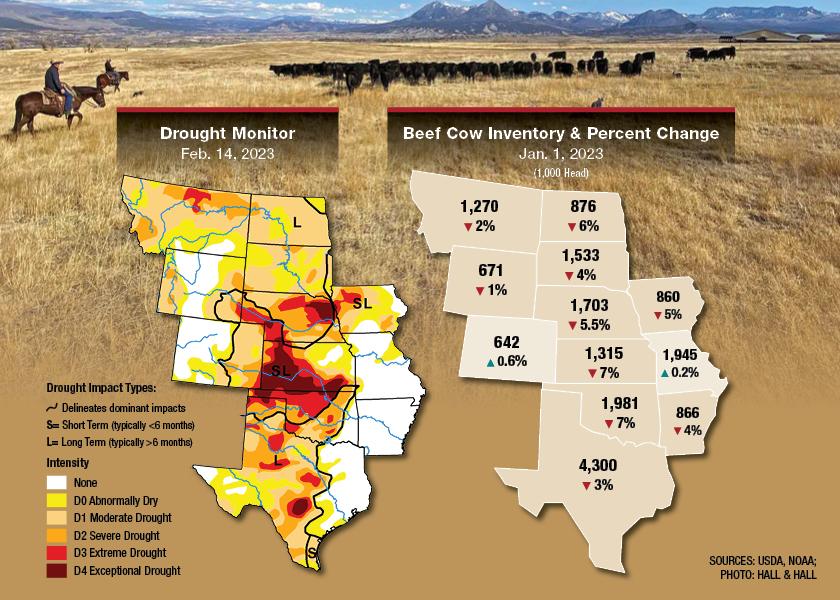Restocking Will Be a Slow-Go

Decimated by a second mega-drought this century, America’s ranchers are struggling to survive. Last year’s perfect storm of economic and weather-related challenges led to the fourth consecutive year of declining cattle inventories.
The US Department of Agriculture’s annual cattle inventory report, issued Jan. 31, confirmed the dramatic herd liquidation analysts expected. The total inventory of cattle and calves was 3% lower, dropping under 90 million head for the first time since 2015.
More importantly, America’s beef cow herd declined below the prior cycle low in 2014 to 28.9 million head, the smallest since 1962. Last year saw 13% of the beef cow herd sent to slaughter, the highest percentage since 1984, resulting in an inventory reduction of 1.06 million beef cows (3.6%), with the 12 states making up the Central Plains hit hard.
Those 12 states – TX, OK, KS, AR, MO, CO, NE, IA, SD, ND, MT and WY – account for 62% of the total inventory of beef cows, and last year’s liquidation of 711,000 cows accounted for 67% of the nation’s total decline. Only two of those 12 states saw beef cow numbers increase, Missouri and Colorado, but combined the two only recorded a total increase of 8,000 head.
That the southern half of the Central Plains were hardest hit by drought is reflected in declining cow inventories. Oklahoma recorded the largest decline of beef cows at 140,000, followed by Texas at 125,000, Kansas at 106,000, and Nebraska at 99,000. Those four states, then, accounted for 44% of the nation’s total reduction of beef cows.
Further zeroing in on the drought, Oklahoma appears to have been the bullseye. The Sooner state recorded a 7% decline in beef cows and an 11% decline in total inventory, the largest of the leading cattle states. Kansas also saw a 7% decline in beef cows with a 4% decline in total inventory.

RESTOCKING TIMELINE
While shrinking cattle inventories will lead to higher prices, ranchers remain at the mercy of the weather. Any thoughts of restocking are on hold until rain replenishes the forage supply. Hay stocks in January were already at a 50-year low which means the cupboard is bare as the 2023 growing season begins.
“Even if the rains come and ranchers can begin to restock, there’s indications that many who liquidated their herds over the past two years have no intention of getting back in the business,” says Sterling Marketing president John Nalivka. “Those that plan to restock are likely to take a very cautionary approach to herd rebuilding.”
That’s one reason Nalivka and other industry analysts believe restocking this cycle will be slow, with further inventory declines likely in 2024 and 2025.
“The industry slaughtered 37.3% of its Jan. 1, 2022, inventory last year, the highest number since 1978,” Nalivka says. “Last year we slaughtered 52% of the heifers weighing more than 500 pounds, the highest percentage since 2004. The recent inventory reported heifers weighing more than 500 pounds down 4% and the lowest since 2014. Additionally, the number of beef replacement heifers was down 6% and the lowest since 2011. So, the total number of heifers in the inventory was nearly one million head fewer.”
Which suggests restocking will be a slow-go even with drought relief. Some heifers that were slated as feeder heifers could still be shifted back to the breeding herds this spring, but most analysts see that as unlikely. That suggests this fall will be the next opportunity to retain heifer calves, which seems more likely given the drought recovery most regions will require. That time table puts heifers retained this fall on schedule to calve in the spring of 2025, reinforcing the idea that any expansion won’t appear until at least 2026.
Such a scenario means calf crops will decline this year and next, and heifer retention will continue to tighten the available supplies of feeder cattle and calves.







